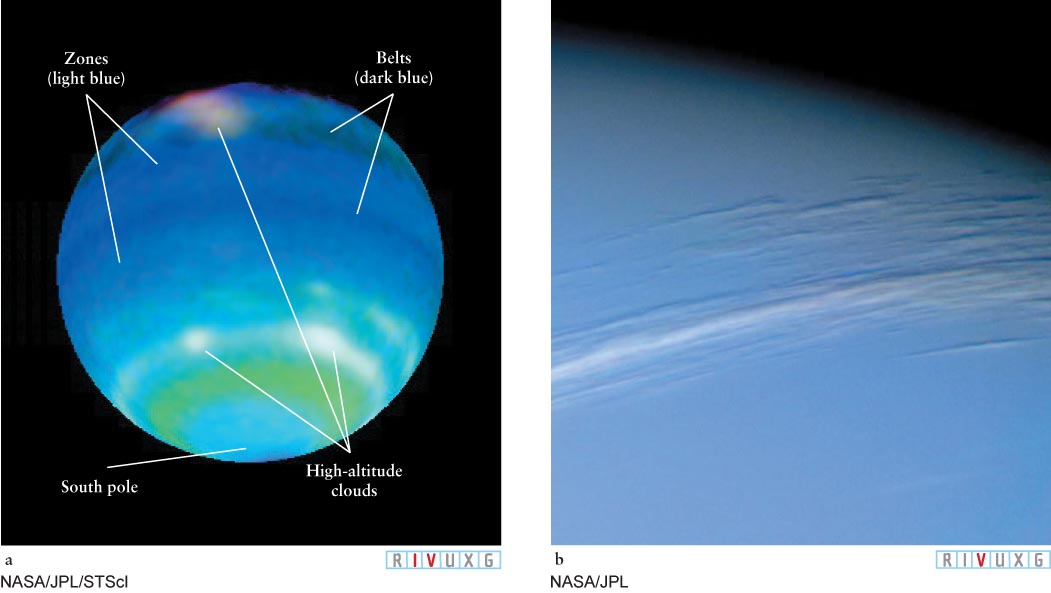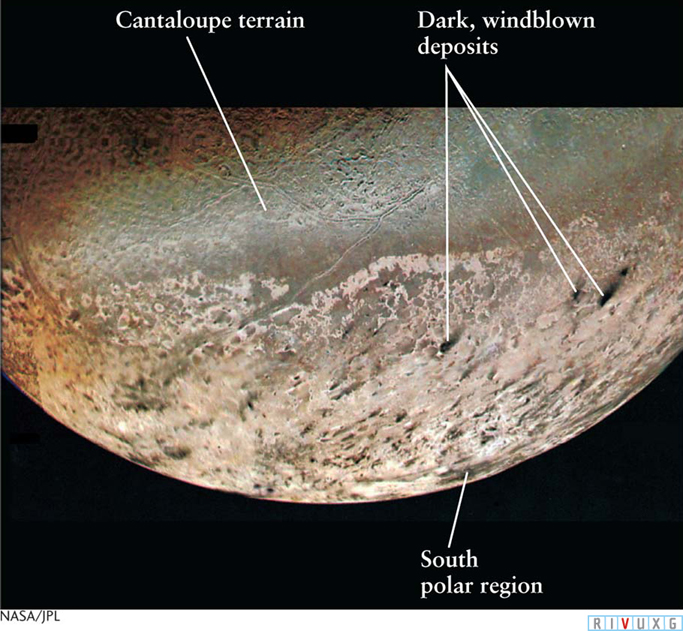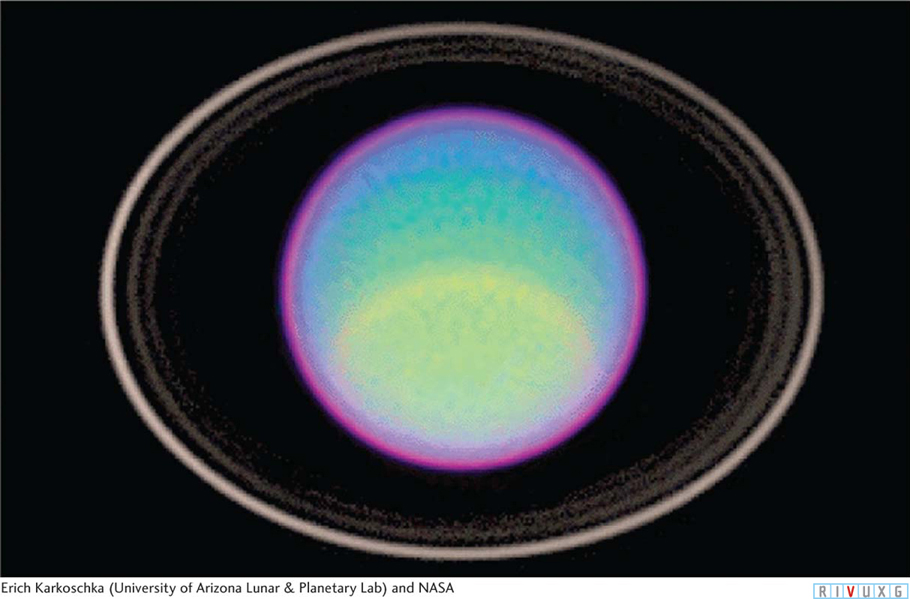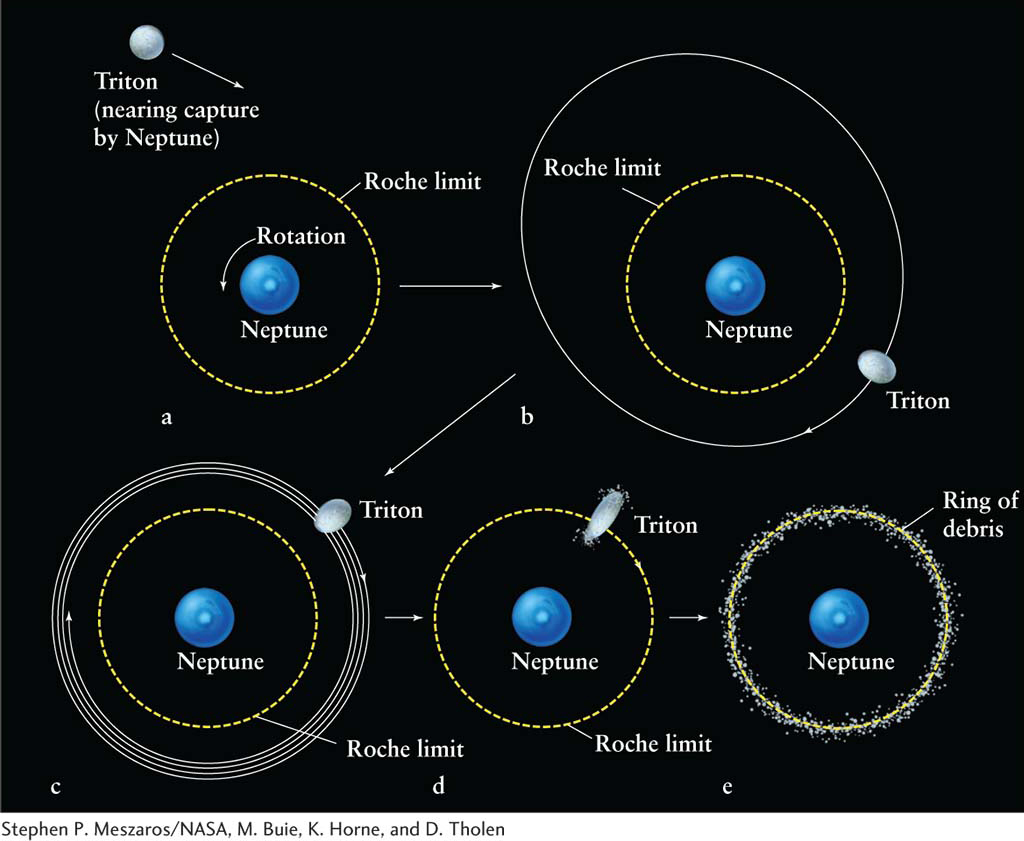NEPTUNE
Neptune is physically similar to Uranus (review Figures 7-

225
7-16 Neptune was discovered because it had to be there
Neptune’s discovery is storied because it illustrates a scientific prediction leading to an expected discovery. Recall from Section 2-
Independent, nearly simultaneous, calculations by an English mathematician, John Adams, and a French astronomer, Urbain Leverrier, predicted the same location for the alleged planet. That planet, Neptune, was located in 1846 by the German astronomer Johann Galle, within a degree or two of where it had to be to have the observed influence on Uranus.
In August 1989, nearly 150 years after Neptune’s discovery, Voyager 2 arrived at the planet to cap one of NASA’s most ambitious space missions. Scientists were overjoyed at the detailed, close-
At the time Voyager 2 passed it, a giant storm raged in Neptune’s atmosphere. Called the Great Dark Spot, the storm was about half as large as Jupiter’s Great Red Spot. The Great Dark Spot (Figure 7-42) was located at about the same latitude on Neptune and occupied a similar proportion of Neptune’s surface as the Great Red Spot does on Jupiter. Although these similarities suggested that similar mechanisms created the spots, the Hubble Space Telescope in 1994 showed that the Great Dark Spot had disappeared. Then, in April 1995, another spot developed in the opposite hemisphere.
Focus Question 7-14
The “spots” on Neptune are analogous to what features in Earth’s atmosphere?
226

Neptune’s interior is believed to be very similar in composition and structure to that of Uranus: a rocky core surrounded by ammonia and methane-
Insight Into Science
Process and Progress Astronomers were able to predict Neptune’s position on the basis of theory before it was observed. Likewise, the volcanoes on Io were also predicted. In other cases in science, theories have correctly predicted results even before the technology existed to verify them. Once confirmed, valid theories lead to other predictions and further scientific understanding.
We saw in Section 7-
7-17 Neptune has rings and captured moons
Like Uranus, Neptune is surrounded by a system of thin, dark rings (Figure 7-43). At these distances from the Sun it is so cold that both planets’ ring particles retained methane ice. Scientists speculate that eons of radiation damage have converted this methane ice into darkish carbon compounds, thus accounting for the low reflectivity of the rings.
227
Neptune has 14 known moons. Thirteen have irregular shapes and highly elliptical orbits, which suggest that Neptune captured them. Triton, discovered in 1846, is spherical and was quickly observed to have a nearly circular, retrograde orbit around Neptune. It is difficult to imagine how a planet rotating one way and a satellite revolving the other way could form together. Indeed, only the small outer satellites of Jupiter and Saturn have retrograde orbits, and these bodies are probably captured asteroids. Some scientists have therefore suggested that Triton was also captured 3 or 4 billion years ago by Neptune’s gravity. Upon being captured, Triton was most likely in a highly elliptical orbit. However, the tides that the moon creates on Neptune’s liquid surface would, in turn, have made Triton’s orbit more circular.
Triton’s average density of about 2100 kg/m3 (3540 lb/yd3) indicates that it is an equal mix of rock and ice. It has a thin nitrogen, methane, and carbon dioxide atmosphere, which changes density with the seasons on that world. When Triton was younger, the tidal force exerted on it by Neptune due to the moon’s initially elliptical orbit caused Triton to stretch and flex, providing enough energy to melt much of its interior and obliterate its original surface features, including craters. Triton’s south polar region is shown in Figure 7-44. Note that very few craters are visible. While cratering continued, so did resurfacing. Calculations indicate that Triton’s present surface is only about 100 million years old.


Triton does exhibit some surface features seen on other icy worlds, such as long cracks resembling those on Europa and Ganymede. Other features unique to Triton are quite puzzling. For example, the top part of Figure 7-
228
Voyager instruments measured a surface temperature of 36 K (−395°F), making Triton the coldest world that our probes have ever visited. Nevertheless, Voyager cameras did glimpse two towering plumes of gas extending up to 8 km (5 mi) above the satellite’s surface. These are apparently jets of nitrogen gas warmed by interior radioactive decay and escaping through vents or fissures.
Focus Question 7-15
Is our Moon inside or outside Earth’s Roche limit?
Triton continues to create tides on Neptune. Whereas the tides on Earth cause our Moon to spiral outward, the tides on Neptune cause Triton (in its retrograde orbit) to spiral inward. Within the next quarter of a billion years, Triton will reach the Roche limit, at which time pieces of Triton will then literally float into space until the entire moon is demolished! By destroying Triton, Neptune will create a new ring system that will be much more substantial than its present one (Figure 7-46).



 Neptune’s Banded Structure (a) Several Hubble Space Telescope images at different wavelengths were combined to create this enhance
Neptune’s Banded Structure (a) Several Hubble Space Telescope images at different wavelengths were combined to create this enhance